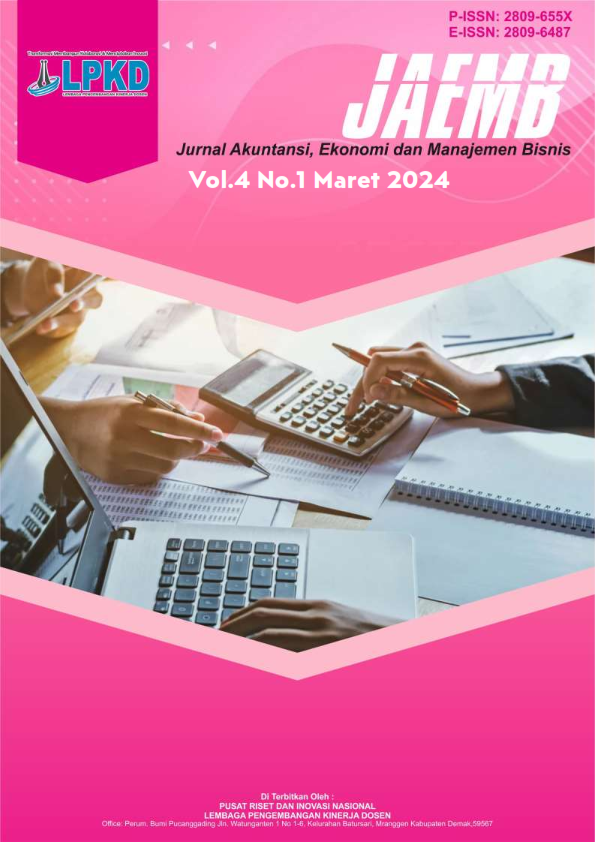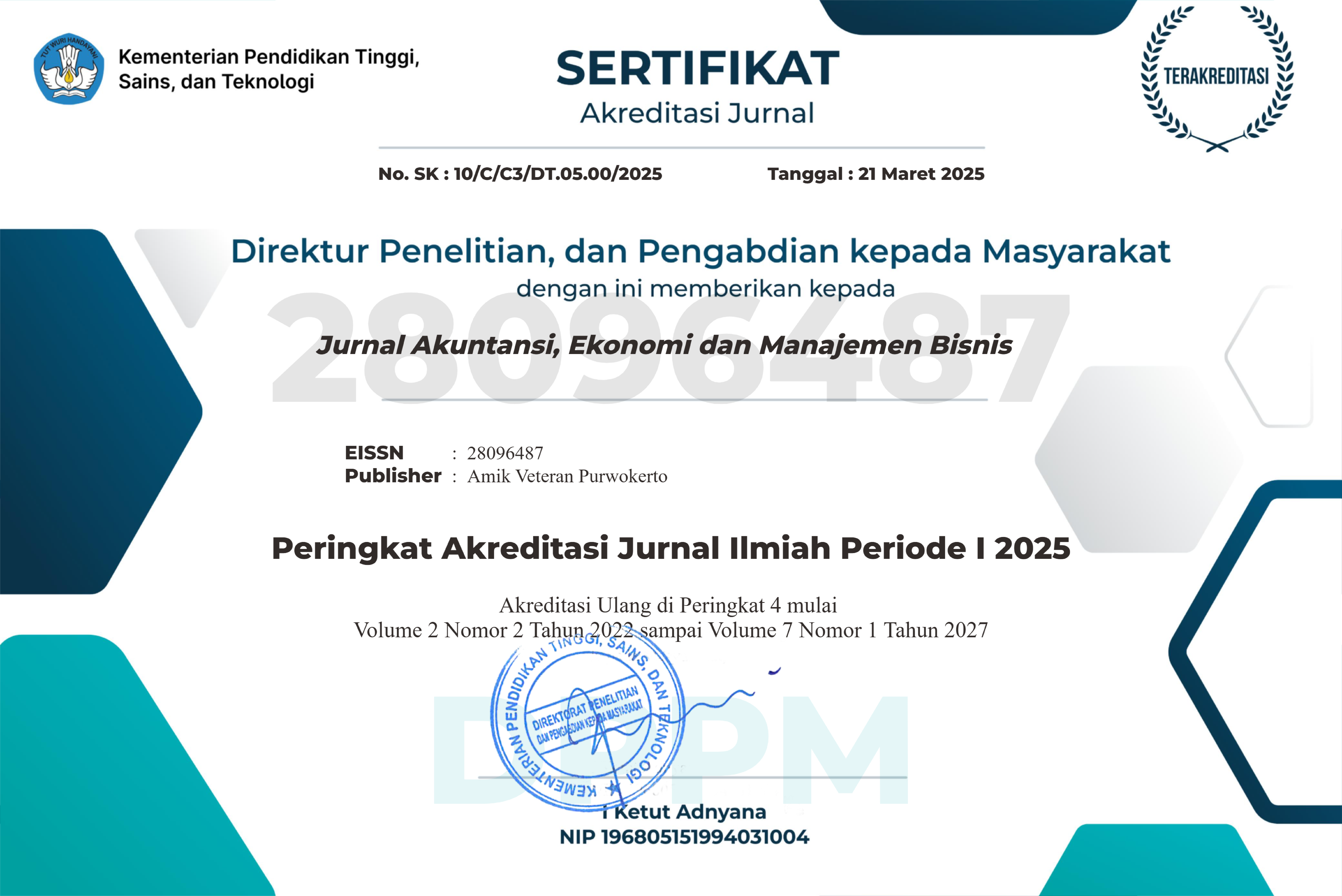Green Perceived Value Analysis of Green Repurchase Intention: The Role of Green Trust in Fast Moving Consumer Goods (FMCG) Products
DOI:
https://doi.org/10.55606/jaemb.v5i1.7937Keywords:
Green Trust, Green Perceived Value, Green Repurchase Intention, Green Marketing Strategy, FMCGAbstract
The increasing number of news reports in the mass media about global warming and environmental damage has now become a neglected issue. This has triggered customers to value environmentally friendly products more. The focus of this study is to analyze how perceived green values are related to the intention to repurchase green cosmetic products by using green beliefs as an intervening variable. This study used purposive sampling to collect a sample of 96 respondents. This study used the path analysis method. The results of the analysis indicate that perceived green values have a positive and significant effect on green purchase intentions; perceived green values have a positive and significant effect on green purchase intentions; perceived green values have a positive and significant effect on green purchase intentions; and perceived green values significantly mediate the effect of perceived green values on green purchase intentions. In the future, it is hoped that cosmetic companies will promote the benefits of using green cosmetic products more, as well as improve the quality and quality of the products they produce.
References
[1] K. Azmi Yoningsih and D. S. Hidayat, “Pengaruh Green Brand Image dan Green Perceived Value Terhadap Green Trust untuk Meningkatkan Green Satisfaction (Studi Pada Restoran Vegetarian Kehidupan Tidak Pernah Berakhir Kota Bandung),” J. Bisnis dan Manaj. West Sci., vol. 2, no. 04, pp. 315–332, 2023, doi: 10.58812/jbmws.v2i04.776.
[2] A. Y. C. Lam, M. M. Lau, and R. Cheung, “Modelling the Relationship among Green Perceived Value, Green Trust, Satisfaction, and Repurchase Intention of Green Products,” Contemp. Manag. Res., vol. 12, no. 1, pp. 47–60, 2016, doi: 10.7903/cmr.13842.
[3] Z. Tan, B. Sadiq, T. Bashir, H. Mahmood, and Y. Rasool, “Investigating the Impact of Green Marketing Components on Purchase Intention: The Mediating Role of Brand Image and Brand Trust,” Sustain., vol. 14, no. 10, p. 5939, 2022, doi: 10.3390/su14105939.
[4] Y. S. Chen and C. H. Chang, “Towards green trust: The influences of green perceived quality, green perceived risk, and green satisfaction,” Manag. Decis., vol. 51, no. 1, pp. 63–82, 2013, doi: 10.1108/00251741311291319.
[5] C. Mombeuil and H. P. Diunugala, “Investigating the sustainability of the tourism industry through consumer intention to purchase electric three-wheelers: the case of Sri Lanka,” Int. J. Tour. Cities, vol. 10, no. 4, pp. 1210–1230, 2024, doi: 10.1108/IJTC-11-2023-0250.
[6] N. N. N. Pratiwi and N. N. K. Yasa, “Peran Green Trust Memediasi Pengaruh Green Perceived Value Dan Kepuasan Konsumen Terhadap Green Repurchase Intention,” E-Jurnal Manaj. Univ. Udayana, vol. 8, no. 12, p. 7281, 2019, doi: 10.24843/ejmunud.2019.v08.i12.p19.
[7] M. T. Ha, V. T. K. Ngan, and P. N. D. Nguyen, “Greenwash and green brand equity: The mediating role of green brand image, green satisfaction and green trust and the moderating role of information and knowledge,” Bus. Ethics, Environ. Responsib., vol. 31, no. 4, pp. 904–922, 2022, doi: 10.1111/beer.12462.
[8] R. Cheung, A. Y. C. Lam, and M. M. Lau, “Drivers of green product adoption: the role of green perceived value, green trust and perceived quality,” J. Glob. Sch. Mark. Sci. Bridg. Asia World, vol. 25, no. 3, pp. 232–245, 2015, doi: 10.1080/21639159.2015.1041781.
[9] M. Thakur, Madhu, and R. Kumar, “Analysing the aspects of sustainable consumption and impact of product quality, perceived value, and trust on the green product consumption,” Int. Soc. Sci. J., vol. 73, no. 248, pp. 499–513, 2023, doi: 10.1111/issj.12412.
[10] S.-Y. Huang and Y.-C. Yeh, “Perspective of Triple Button Lines: Influence of Green Product Value,” Int. Bus. Econ. Stud., vol. 3, no. 3, p. p15, 2021, doi: 10.22158/ibes.v3n3p15.
[11] K. Tan and C. Huang, “the Influence of Government Support on Green Purchase Intention,” EUrASEANs J. Glob. socio-economic Dyn., vol. 5, no. 42, pp. 117–127, 2023, doi: 10.35678/2539-5645.5(42).2023.117-127.
[12] T. Pimonenko, O. Chygryn, and O. Lyulyov, “Green Branding As a Driver To Boost the Development of Green Investment Market,” Cherkasy Univ. Bull. Econ. Sci., no. 1, pp. 144–150, 2019, doi: 10.31651/2076-5843-2019-1-144-150.
[13] N. Hasanah and W. Handayani, “Pengaruh Green Product, Green Advertising dan Green Trust Terhadap Keputusan Pembelian Skincare Himalaya Herbals di Palapa Toserba Surabaya,” J. Stud. Manaj. dan Bisnis, vol. 7, no. 1, p. Inpress, 2020, doi: 10.21107/jsmb.v7i1.7459.
[14] P. Jia, Y. Tang, and Y. Du, “How is the value of the exhibition brand in the eyes of the audience? Based on the perspective of green practice,” Front. Psychol., vol. 13, 2022, doi: 10.3389/fpsyg.2022.1019508.
[15] S. Kang and W. M. Hur, “Investigating the Antecedents of Green Brand Equity: A Sustainable Development Perspective,” Corp. Soc. Responsib. Environ. Manag., vol. 19, no. 5, pp. 306–316, 2012, doi: 10.1002/csr.281.
[16] R. Zulfikar, “The Influence of Green Brand Image on Green Brand Trust Equity Mediated by Green Trust,” Proceeding Int. Conf. Business, Econ. Soc. Sci. Humanit., vol. 1, pp. 516–522, 2020, doi: 10.34010/icobest.v1i.82.
[17] D. Rakhmawati, A. Puspaningrum, and D. Hadiwidjojo, “Hubungan green perceived value, green brand image, dan green trust terhadap green purchase intention,” J. Ekon. dan Bisnis Islam, vol. 15, no. 1, pp. 1–16, 2019.
[18] Y. Chen and C. Chang, “Enhance Green Purchase Intentions: The Roles of Green Perceived Value, Green Perceived Risk, and Green Trust,” Manag. Decis., vol. 50, no. 3, pp. 502–520, 2012.
[19] Y. Chen, “Green organizational identity: sources and consequence,” Manag. Decis., vol. 49, no. 3, pp. 384–404, 2011.
[20] A. La Mada, I. Hidayanti, and I. S. H. Yusuf, “Efek Green Perceived Value dan Risk terhadap Green Repurchase Intention: Green Trust sebagai Pemediasi pada Pengguna Pertalite di Kota Ternate,” INOBIS J. Inov. Bisnis dan Manaj. Indones., vol. 4, no. 3, pp. 326–345, 2021.
[21] S. A. Dewi and N. M. Rastini, “Peran Green Trust Memediasi Green Perceived Value Dan Green Perceived Risk Terhadap Green Repurchase Intention,” Manaj. Unud, vol. 5, no. 12, pp. 8046–8078, 2016.
[22] E. Sofyan, U. J. A. S. Anwar, and N. Susanto, “Pengaruh Kemasan Ramah Lingkungan terhadap Keputusan Pembelian Produk Perawatan Pribadi (Fast Moving Consumer Goods),” J. Bisnis Mhs., vol. 5, no. 4, pp. 1683–1695, 2025.
[23] J. Hartono and W. Abdillah, Konsep dan Aplikasi PLS (Partial Least Square) Untuk Penelitian Empiris. 2009.
[24] N. Sulistyowati, A. Akhmadi, and L. Lutfi, “Pengaruh Motivasi Ekstrinsik, dan Lingkungan Kerja Fisik Terhadap Kinerja Karyawan Dengan Kepuasan Kerja Karyawan Sebagai Variabel Intervening,” J. Ris. Bisnis dan Manaj. Tirtayasa, vol. 1, no. 2, 2017.
[25] I. Ghazali and H. Latan, Partial Least Squares: Konsep, Teknik dan Aplikasi Menggunakan Program Smart PLS 3.0. 2015.
[26] A. Juliandi, “Structural Equation Model Partial Least Square (SEM-PLS) Dengan SmartPLS,” Modul Pelatih., vol. 1, no. 4, pp. 1–6, 2018.
[27] Y. T. Amelia and K. Safitri, “Pengaruh Kualitas Pelayanan Dan Fasilitas Terhadap Loyalitas Melalui Kepuasan Konsumen Pada Café Hangout Di Sampit,” Coopetition J. Ilm. Manaj., vol. 12, no. 1, pp. 95–106, 2021, doi: 10.32670/coopetition.v12i1.296.
[28] K. Khairunnisa, F. F. Sari, M. Anggelena, D. Agustika, and E. Nursa’adah, “Penggunaan Effect Size Sebagai Mediasi Dalam Koreksi Efek Suatu Penelitian,” J. Pendidik. Mat. Judika Educ., vol. 5, no. 2, pp. 138–151, 2022.
[29] M. Sarstedt, C. M. Ringle, and J. F. Hair, “Partial Least Squares Structural Equation Modeling,” in Handbook of Market Research, Springer, 2021, pp. 587–632. doi: 10.1007/978-3-319-57413-4_15.
[30] K. D. S. Putra and N. M. Rastini, “Pengaruh Green Perceived Value Dan Green Perceived Quality Terhadap Green Satisfaction Dan Green Trust,” 2017, Udayana University.
[31] T. Jonathan, “Peran green trust dalam memediasi green perceived value terhadap green repurchase intention pada produk lampu led di jakarta,” J. Manaj. Bisnis Dan Kewirausahaan, vol. 6, no. 1, p. 68, 2022.
[32] N. P. I. Cahyanti and N. W. Ekawati, “Green trust memediasi green perceived value dan green perceived risk terhadap green repurchase intention,” 2021, Udayana University.
[33] O. Owen, F. D. Pranatasari, and L. Kurniawati, “Pengaruh Green Perceived Risk dan Green Perceived Value Terhadap Green Repurchase Intention Dengan Green Trust Sebagai Mediasi,” Parsimonia-Jurnal Ekon. dan Bisnis, vol. 11, no. 2, pp. 86–97, 2024.
Downloads
Published
How to Cite
Issue
Section
License
Copyright (c) 2025 Jurnal Akuntansi, Ekonomi dan Manajemen Bisnis

This work is licensed under a Creative Commons Attribution-ShareAlike 4.0 International License.








